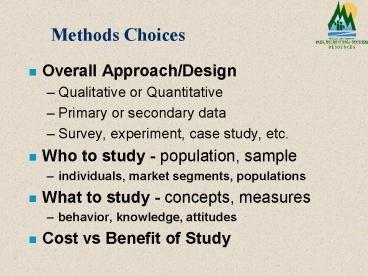Methods Choices - PowerPoint PPT Presentation
1 / 10
Title:
Methods Choices
Description:
Survey, experiment, case study, etc. Who to study - population, sample ... Survey vs Experiment. Survey - measure things as they are, snapshot of population at ... – PowerPoint PPT presentation
Number of Views:25
Avg rating:3.0/5.0
Title: Methods Choices
1
Methods Choices
- Overall Approach/Design
- Qualitative or Quantitative
- Primary or secondary data
- Survey, experiment, case study, etc.
- Who to study - population, sample
- individuals, market segments, populations
- What to study - concepts, measures
- behavior, knowledge, attitudes
- Cost vs Benefit of Study
2
- Quantitative Framework
- Inquiry into a social or human problem based on
- testing a theory,
- composed of variables,
- measured with numbers,
- and analyzed with statistical procedures
- to determine if predictive generalizations of
the theory hold true
3
- Qualitative Framework
- An inquiry process of understanding a social or
human problem, based on - building a complex, holistic picture,
- formed with words,
- reporting detailed views of informants
- and conducted in a natural setting
4
Qualitative vs Quantitative Approaches
Qualitative Focus Group In-Depth
Interview Case Study Participant
observation Secondary data analysis Quantitative
Surveys Experiments Structured
observation Secondary data analysis
5
Qualitative vs Quantitative
Quantitative Genl Laws Test Hypotheses Predict
behavior Outsider-Objective Structured formal
measures probability samples statistical
analysis
Qualitative Unique/Individual case Understanding M
eanings/Intentions Insider-Subjective Unstructur
ed open ended measures judgement samples
interpretation of data
Purpose Perspective Procedures
6
Primary or Secondary Data
- Secondary data are data that were collected for
some purpose other than your study, e.g.
government records, internal documents, previous
surveys - Choice between Primary /Secondary Data
- Costs (time, money, personnel)
- Relevance, accuracy, adequacy of data
7
Research Designs/Data Collection Approaches
8
- Survey vs Experiment
- Survey - measure things as they are, snapshot of
population at one point in time, generally refers
to questionnaires - (telephone, self-administered, personal
interview) - Experiment - manipulate at least one variable
(treatment) to evaluate response, to study
cause-effect relationships - (field and lab experiments)
9
General Guidelines on when to use different
approaches
- 1. Describing a population - surveys
- 2. Describing users/visitors - on-site survey
- 3. Describing non-users, potential users or
general population - household survey - 4. Describing observable characteristics of
visitors - on-site observation - 5. Measuring impacts, cause-effect relationships
- experiments
10
Guidelines (cont)
- 6. Anytime suitable secondary data exists -
secondary data - 7. Short, simple household studies - phone
- 8. Captive audience or very interested population
- self-administered survey - 9. Testing new ideas - experimentation or focus
groups - 10. In-depth study - in-depth personal
interviews, focus groups, case studies































